Chapter Six
"The Sweet, Sad Poetry of Female Labor":
Raphael Soyer's Weary Shop Girls
I was always out. I saw these people. I studied their faces and their gestures, their habits. And then I made compositions. . .. I watched them come out of the shop, you know, and they were less fancy, more informal, more casual than the other girls.
RAPHAEL SOYER on his Shop Girls, December 27, 1982
There is no time for pleasure in her life, no time for the softer, sweeter, tenderer things of womanhood. It is a life stripped of humanity, robbed of most that makes life beautiful, and spent in one ceaseless, perpetual grind—simply to live. . .. There are many among them, who, in spite of the difficulties in the way of courtship, will become loved wives and mothers, and there are many who will become prosperous business women, and do a creditable share in the world's work.
MARY K. MAULE , "What Is a Shop-Girl's Life?" 1907
In the late 1920s, Raphael Soyer gained critical attention with paintings of sparsely populated city neighborhoods, family gatherings, and seminude or clothed female models in intimate studio settings. Because of a high-key palette and the flat, unmodeled quality of the figures, early works like Odalisque (1928; Fig. 6.1) have a naive, almost decorative, quality. By the mid-1930s, however, the artist had expanded both his subject matter and his repertoire of "realist" Depression era conventions; darkening his colors and working in sharply contrasting values, he made his figures more substantial. His depictions of unemployed men ensured his reputation as a sympathetic chronicler of the Depression; in his paintings of women
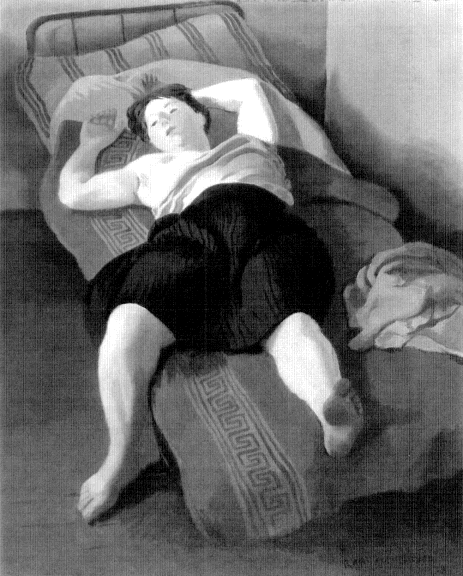
6.1
Raphael Soyer, Odalisque, 1928. Oil on canvas, 25 1/8" × 20 1/8". Columbus Museum
of Art, Columbus, Ohio.
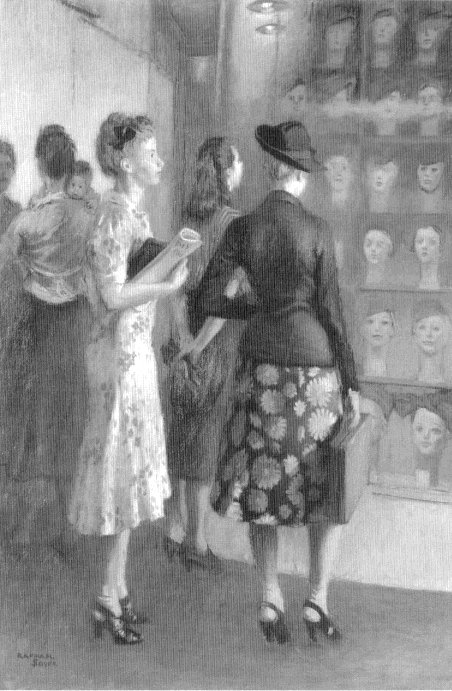
6.2
Raphael Soyer, Window Shoppers, 1938. Oil on canvas, 36" × 24". New Jersey State
Museum, Trenton.
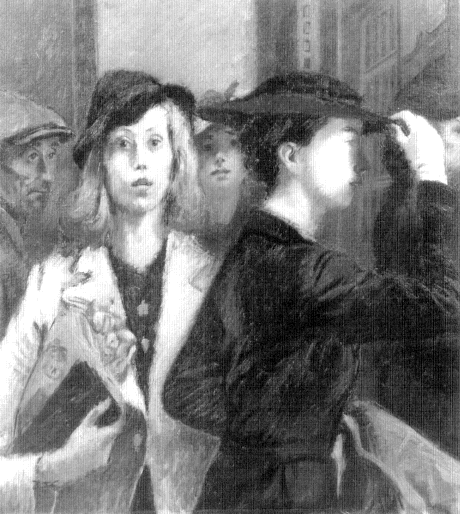
6.3
Raphael Soyer, Office Girls, 1936. Oil on canvas, 26" × 24". Collection of Whitney
Museum of American Art.
in the Fourteenth Street neighborhood, he also took up contemporary social issues.
By the mid-1930s, Soyer's casually posed female models began to appear in groups as urban types, placed outdoors in minimally described street settings that often featured store window displays.[1] The female types in Window Shoppers , for example (1938; Fig. 6.2 and Plate 5), encompass the multiple roles of the revised
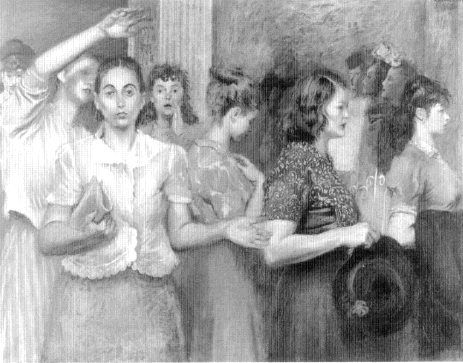
6.4
Raphael Soyer, Shop Girls, 1936. Oil on canvas, 30" × 40". Collection of Babette B.
Newburger.
new woman; three working women (the one in a suit jacket carrying a briefcase is probably an office worker) survey rows of hats while a more simply clad mother holding her child has turned her back to the viewer to enter the store. In Office Girls (1936; Fig. 6.3) working women against a skyscraper backdrop hurry home. In Lunch Hour (1936), which Soyer originally called Fourteenth Street Midinettes (midinettes , literally "little noon girls," refers to young Parisian dressmakers or milliners), the artist showed young milliners mingling with other passersby on their lunch hour. And in Shop Girls (Fig. 6.4; Plate 6), the work I consider in this chapter, the artist depicted seven retail salesclerks coming out of a Fourteenth Street shop at the end of the day.
In Shop Girls we move, figuratively at least, to the other side of the counter. Without abandoning the realm of consumer capitalism, we turn from the woman consumer to the woman worker, and to a subject also treated by Kenneth Hayes Miller in several paintings of department store saleswomen helping their customers
(Figs. 3.14, 4.25, 4.27, and 6.12). But Soyer's female imagery stands in marked contrast to Miller's and Marsh's. First, Soyer's realism was based on artistic sources, studio practices, and compositional strategies that differed substantially from those of the other artists. Second, with the choice of shopgirls over Miller's department store salesladies, Soyer not only portrayed the typical effects of working life in Fourteenth Street's bargain emporiums and a struggling specialty shops but also addressed the ambiguous, even inconsistent, gender and class conflict of the retail sales profession. By the 1930s the once interchangeable terms shopgirl and saleslady described women of different social classes and educational backgrounds who worked for different kinds of stores. The shopgirl retained at least part of her turn-of-the-century persona as an unskilled, poorly educated working girl, often from a lower-class immigrant background. By the 1920s, she had lost her status to the newly professionalized saleslady, a "skilled seller" who worked in the fully rationalized urban department store; by the 1930s she held mainly backstage jobs in department stores, bargain stores, and five and dimes.[2] Even though this feminized occupation was frequently considered either transitional work between school and marriage or even part-time work, store owners and job counselors billed the saleslady as a new model of feminine achievement. Both working-class females and refined, middle-class, college-educated new women, who increasingly looked on work as a respectable pursuit, accepted these service positions behind the retail display counter.
The pictorial rhetoric of Soyer's shopgirls and Miller's salesladies reinforces distinctions that often remained blurred and relations that remained contradictory throughout the Depression. As Susan Porter Benson has shown in Counter Cultures , department store managers, customers, and saleswomen held different, shifting, patterns of expectation about class and gender—about women's roles as workers and consumers. In many stores, working saleswomen formed an informal "clerking sisterhood," an alliance that allowed them substantial flexibility in interpreting a masculine middle-class management's dictates on how and what to sell their female clients. Female customers were perceived variously by the sales staff, depending on the situation: as middle- to upper-middle-class "enemies," female shoppers conspired with managers to keep the socially inferior woman worker in her place, but as female "allies" they worked with saleswomen to close a mutually beneficial sale. Whatever the dynamic, such mobile configurations in saleswomen's work culture alternately enhanced the saleswoman's power and kept her in a socially and economically disadvantaged position.[3]
Soyer's painting foregrounds an escalating (though historically long-standing) tension in the discourse of new womanhood between "femininity" and "labor." This occurs because Soyer, like Marsh—though by different means—operates in multiple registers, constructing gender between intersecting discourses. Because the painting features individualized shopgirls, it explores a class-specific discourse on
women and work. From this vantage point, Soyer's image is more fully engaged than works by other Fourteenth Street artists—and more concerned with the social effects of Depression era labor conditions and ideologies related to working-class women. But Soyer's means of attaining this heightened social awareness are subtle and covert rather than direct: his images have no specific work-related setting; the artist retained studio conventions for outdoor pictures; and his paintings evoke an earlier, and by the 1930s romanticized, image of the shopgirl as the long-suffering companion of the artist, a social outcast. By employing these accepted pictorial conventions, Soyer's painting continued to register within the discursive boundaries of American Scene realism rather than social realism. At the same time, however, the painting disrupts the rhetoric of success embodied in the saleslady by interrogating the idealized or glamorized models of womanhood found in works by artists like Miller and Marsh. Because the work addresses the politics of both class and gender within the overlapping discursive fields of urban realism and working-class womanhood, it embodies many of the conflicted social relations and shifting attitudes related to women and work in the Depression.[4]
Shop Girls pictures seven youthful white women emerging from a drab store at the end of a summer day. Their colorful short-sleeved blouses are rumpled, their hair unkempt; one carries a coat, another a hat. Several of the women look especially tired. Dark shadows frame the eyes of the woman with a magazine under her right arm who faces the viewer (Fig. 6.5). Her face is drawn and pinched like that of the woman holding her hat (Fig. 6.6). The woman in the center lowers her head, closes her eyes, and raises a limp hand to her throat in an inward-turning gesture of weariness. Even the women who communicate with unseen figures lack energy and animation. The flattened position of the open hand and the angled position of the arm and tilted head of the woman to the far left suggest that she must make a substantial effort to raise her arm and call to someone outside the picture.
The rudimentary storefront setting itself is cramped and dingy. Soyer painted the window backdrop, like the brown skirt of the figure who faces forward, with random brushstrokes, so that the surface appears unfinished, deliberately rough. He chose a dull palette of brown, rust, and ochre, enlivened by the garish corals, blues, and whites of the shopgirls' patterned blouses, the patterns and paint blotchy or coarse.
Compositionally, there is barely enough room for the figures. They occupy a shallow space parallel to the picture plane. Cut off above the knees, their figures fill virtually the entire canvas. The setting is minimal (a store window with three mannequins and a pilaster at the store entrance), and as a consequence the women are close to the viewer. This proximity of full-bodied individualized women forces us to experience the sense of crowding. The discomfort is most intense at the left side of the canvas, where four of the women are packed together at the store entrance. Even more important, it forces us to concentrate on these shopgirls as
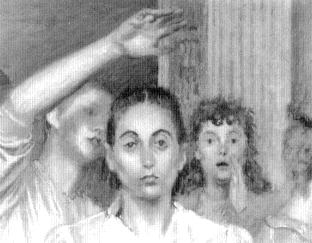
6.5
Detail of Shop Girls (Fig. 6.4).
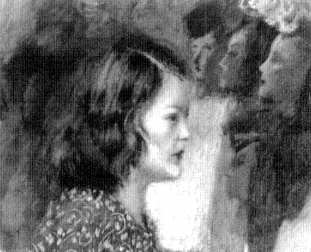
6.6
Detail of Shop Girls (Fig. 6.4).
women. Because they are in transition between environments and are isolated from the locus of any purposeful working, domestic, or leisure activity, these women are meant to be visually available to the viewer.
The melancholy, serious mood of the shopgirls themselves adds to the general dreariness of the environment. Within this somber emotional range, weariness, anxiety, and self-preoccupation are expressed through the use of carefully arranged poses, gestures, and facial expressions. Yet strange and somewhat inconsistent pat-
terns of interaction contribute a feeling of tension or unease to the picture. The women are physically close. The linked arms that extend across the foreground and help to define the left-to-right movement of the figures and the actual painted merging of one form into another imply a camaraderie among the women. These are the sturdy limbs of labor, attached to stocky bodies that signify work rather than femininity. At the center of the picture, two horizontal forearms, their muscles carefully delineated, dictate the group's momentum, framing the vertical arm of the reflective figure at the center of the picture. Yet, for all this structural connection, there is little emotional interaction. Figures remain psychologically isolated, communicating not with one another but with people or events outside the picture. The extent to which these aspects of mood, physical condition, and psychological relationship can be attributed to the effects of work on these women will be demonstrated presently. But the curious disjunction between elements that suggest closeness and those that insist on separation permeates the work.
Adding to this disjunction are the ambiguous transactions that occur between subject and viewer. Most of the women show no awareness of, or response to, an observing presence. As viewers, however, we are physically close to these shopgirls, and two of the women look toward us: the foreground figure turns our contemplation of her back on itself by observing us. Because of the unfocused cast of her eyes (Fig. 6.5), her gaze is quiet and serious rather than demanding or sexually provocative. Indeed, unlike Marsh's paintings of alluring Sirens, this painting does not insistently address a masculine viewer. Soyer's women are portrayed as substantial and relatively unprovocative rather than curvaceously slender and self-consciously seductive. Furthermore, in confronting us, Soyer's central figure gently asserts her individuality and plays several possible roles. Through her gaze and the questioning, tentative gesture of her upturned palm, she may be interrogating us or someone beyond the confines of the picture. Or, because she stands slightly in front of the rest of the group and therefore detached from it, her enigmatic gesture may be intended to direct our gaze toward her fellow workers. In this capacity, she functions as both a player and a narrator, like St. John the Evangelist in Masaccio's Trinity or Peter and Christ in the sequential narrative of Masaccio's Tribute Money (Fig. 6.7). The latter work, along with Courbet's Burial at Ornans , was Soyer's favorite precedent for groups of figures ranged along a horizontal format.[5] Since Shop Girls lacks an explicit narrative, what is being indicated is not immediately evident.
A comparison between Soyer's Shop Girls and several other works helps to define further some of the artist's distinctive and generally subtle pictorial strategies for showing Depression era female laborers. Among images of American working women prior to the 1930s, John Sloan's 1915 etching Return from Toil (Fig. 3.21) provides one of the few iconographic precedents for Soyer's work. In Sloan's image a similar line of women parade through the streets at the end of the day. But unlike
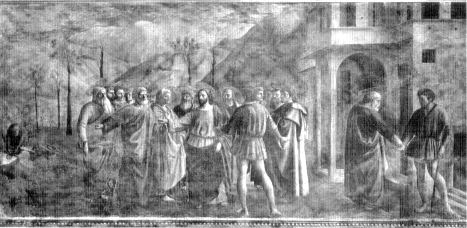
6.7
Masaccio, The Tribute Money, c. 1427. Fresco. Brancacci Chapel, Santa Maria del
Carmine, Florence.
Soyer, Sloan stages a narrative of interaction within the picture. Compositionally these women are at a greater distance from the viewer than those in Shop Girls . They do not engage us, and we observe their energetic flirtations with male passersby—observed in turn by a dispassionately amused constable—instead of participating in their weariness. The linked arms, smiling faces, and lively interactions among Sloan's women signify a spirited camaraderie. They seem buoyed up by their jobs and the new opportunities available to them as working women. In Shop Girls the pace is slower, the mood changed. The daily event of leaving work is never, as one of Soyer's reviewers pointed out, a "glittering" public spectacle but one in a number of ordinary episodes that the artist carefully scrutinized.[6]
A comparison between Shop Girls and two more socially conscious images of the 1930s suggests that while Soyer evokes a mood of weariness, he offers neither overt protest to specific working conditions nor solutions for change. In Eight Figures (Fig. 6.8) the artist Lew Davis depicted seven women sewing in a New York City sweatshop.[7] Like Soyer's shopgirls, the women are emotionally and psychologically distant from one another. But the painting is a stronger critique of women's working lives because we witness the actual conditions of their labor. We watch them stripped down and bent over under the heat of a bare light bulb. Although both Soyer and Davis delineate the musculature of the working woman's arms, Soyer's women nonetheless appear soft because of his more painterly style. Thanks to Davis's firmer definition of forms and the rhyming of the curved sewing machines with tense rounded shoulders, the women seem to become the disciplined body of
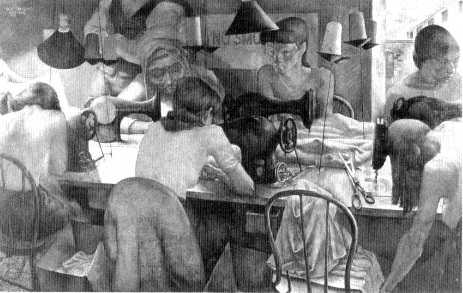
6.8
Lew Davis, Eight Figures , 1935. Oil on board, 29 1/2" × 48". Marjorie and Charles
Benton Collection.

6.9
Joseph Vavak, Women of Flint , 1937. Oil on canvas, 25" × 36". National Museum of
American Art, Smithsonian Institution.
labor merged with the metal machines over which they work, from youth (on the right) to old age (across the table). With Soyer's Shop Girls we see the women only at the end of their working day; in Eight Figures we see the machinery of exploitation along with the faceless male authority figure who stands over the women, whose wooden expressions suggest their inability to protest their plight.
In Women of Flint (1937; Fig. 6.9), the WPA artist Joseph Vavak painted a group of women workers and wives of workers who were part of a massive 1936-37 sit-down strike against General Motors. The most militant faction in this group was referred to as the red berets, whom Vavak immortalized in the group at the right. The women, like figures on a stage, circle in a barren outdoor setting, the strife marked only by the broken gear in the foreground. All the figures are brutally plain, spare, silent, their angular faces anonymous, their postures anguished. Sharply defined winter coats conceal their bodies, denying any hint of womanliness. It is a cold, unrelenting picture of despair; Soyer's Shop Girls seems warm and welcoming by contrast. And, like Davis's Eight Figures, Women of Flint contains a set of narrative strategies that make the picture more immediately comprehensible than Soyer's Shop Girls as an image of exploited or suffering working-class women.[8]
Instead of creating an explicit narrative, Soyer worked to convey a mood through a studied casualness in the arrangement of figures in relation to one another and through penetrating psychological portraits of his subjects. Contemporary critics frequently pointed out Soyer's "uncanny gift of finding the exact bodily gesture that parallels habit of mind" or his serious study of "human psychology" along with human bodies. For thirties critics, Soyer's studies conveyed topical rather than timeless or poetic ends, intensifying a viewer's reaction to a familiar scene of modern urban life. One writer observed that in capturing "the pathos of ordinary people caught unaware," Soyer's art proved "as sensitive a reaction to humanity as it is an accurate piece of reporting."[9] Soyer proclaimed, and critics agreed, that his old master model in this quest was the nineteenth-century French artist Edgar Degas, whose own deliberately haphazard arrangements and revelation of interior moods through pose and gesture Soyer particularly admired. Soyer was inspired both by Degas's images of working women, like laundresses, theatrical performers, and ballerinas, and by his more intimate pictures of models bathing or at their toilettes.[10] And, like the other Fourteenth Street artists Miller and Marsh, Soyer was literal and overt in some of his borrowings. A yawning, stretching laundress in Degas's Ironers (c. 1884; Fig. 6.10) may have provided sources for both the calling woman and the woman with her arm raised at an angle in Shop Girls . Other precedents for the careful orchestration of arm movements to create a sequence of suspended motions appear in some of Degas's frieze-like arrangements of ballet dancers.
The casual yet carefully arranged poses in Shop Girls are also products of the studio picture tradition, in which an artist's model is posed in a studio setting, occasionally with props. The focus is on the figure, often a nude or partially clothed
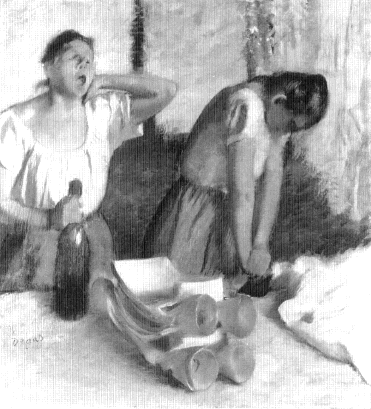
6. 10
Edgar Degas, The Ironers , c. 1884. Oil on canvas, 32 3/8" × 29 3/4".
Norton Simon Art Foundation.
woman arranged as an aesthetic object for the (primarily masculine) viewer's contemplation and pleasure. In the nineteenth century, painters like Degas depicted women bathing or at their toilette. By showing women engaged in intimate activity, Degas's pictures create a mood or allude to a narrative. But he never transformed his women into figures from myth, religion, or history according to academic standards. In fact, as Eunice Lipton has shown, nineteenth-century viewers, equipped with a knowledge of bathing conventions and attitudes toward the body among the bourgeoisie, would have immediately read and understood the bathers as prostitutes cleansing themselves. By the twentieth century, Degas's images—and their influence on Soyer—came to be read less for their social meaning than in the context of a growing preoccupation with formal and aesthetic issues. Many early modernists began to paint the model in a more straightforward fashion, as one of a number
of beautifully composed forms knitting together the picture's composition. This approach served to universalize, to remove historical specificity from the female figure, objectifying or demeaning the model.[11]
In his early work from the end of the 1920s Soyer borrowed his conventions for posing models from the more formal side of the studio picture tradition. In his studies of carefully arranged, flatly painted, evenly lit, and unemotional models like Odalisque (Fig. 6.1), Soyer was guided further by the example of three artists—the French painter Jules Pascin and the Americans Alexander Brook and Yasuo Kuniyoshi. In mainstream American art circles of the 1920s these artists were enormously influential and popular for their aestheticized depictions of nudes and still lifes. Such works took a noncontroversial position, avoiding the polemical realities of contemporary life and the more daring experimentation with formal abstraction conducted by avant-garde modernists.[12]
By the 1930s Soyer's studio pictures had changed in subtle ways. He began to individualize his models and add darker shadows to the tints of his underpainting to create greater luminosity and weightier figures. Then, like Degas, he moved them into settings, posed them, and added props to suggest a particular social context or situation related to the economic deprivation engendered by the Depression. In general, his studio pictures with female models are dark and somber, with the figure spotlit to probe her state of mind. Most of the women are ordinary, tired, rumpled, and sexualized through revealing but nonprovocative poses. Many seem sad. Most are bored or waiting—passive rather than purposeful. Most are reflective, inward-turning figures in settings that are bare or sparsely furnished with unmade dilapidated beds, hard chairs, and old lamps. These are pictures of poverty as opposed to luxury, melancholy as opposed to happiness. In the painting Sentimental Girl (Fig. 5.12), a plain, plump young woman, dressed in a revealing chemise, is captured in an awkward, self-conscious pose as she reflects on an episode from the True Story magazine she holds in her lap. In an empty room with nothing else to do she loses herself in daydreams through the publication understood to be the magazine of the working-class girl. In Kathleen (c. 1933; Fig. 6. 11), a full-bodied woman with unkempt hair huddles, wrapped in an old coat. A bare sink with a small mirror above it provides the only decor. Kathleen, whom Soyer described as one of the few "radical" women he knew, posed several times for him in the 1930s. She appears in Shop Girls as the second figure from the right.
Soyer's shopgirls are like his melancholy studio models. As women who are only moderately sexualized, in part because of snug-fitting blouses, they receive the same kind of scrutiny from artist and viewer. Placed in the traditional reflective or unselfconsciously casual poses of the model moving through the studio as the artist draws her, they too are in transit in a bare setting, available for the viewer's contemplation as womanly objects in a work of art. Although these studio conventions evade the specifics of setting and condition found in works by Davis or Vavak—specifics of
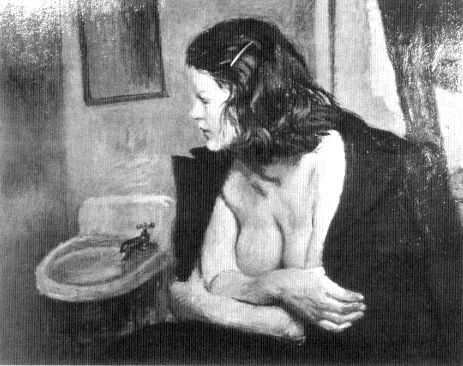
6.11
Raphael Soyer, Kathleen , c. 1933. Oil on canvas, 20" × 24". Present location unknown.
the actual working lives of women—Soyer's shopgirls are nonetheless meant to be seen as Depression era working women on Fourteenth Street. I am thus suggesting that all aspects of the picture I have been describing—the studio picture conventions, the individualization of the models, the tawdry setting, and the melancholy mood—an be interpreted in a specific historical context: shopgirls were frequently alienated lower-class workers, exploited because of the relationship between their sex, their class, and their occupations in places like Fourteenth Street.
In this respect Soyer's Shop Girls differs substantially from Kenneth Hayes Miller's nearly contemporary paintings of saleswomen. As a group Miller's paintings The Fitting Room, Glove Counter, Department Store Shoppers , and Saleswomen (Figs. 3.14, 4.25, 4.27, and 6.12) help to distinguish Soyer's view of Fourteenth Street retail salesclerks as alienated from the workplace and from one another. Instead of melancholy young women in transit, the viewer observes cheerful salesladies in bustling department store interiors helping matronly shopper clients. All
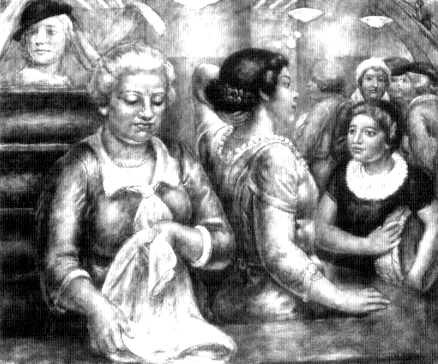
6.12
Kenneth Hayes Miller, Saleswomen , c. 1934. Present location unknown.
the saleswomen seem actively engaged in their tasks, whether they are folding stock, responding to a customer's query from behind the counter, fastening a client into a garment, or peering into a crowded dressing room to see if their services are required. Social interaction among women appears everywhere. In Glove Counter (Fig. 4.25), for example, a relaxed and very feminine saleslady chats amicably with one of her two clients while, across the aisle, three other store workers, momentarily without customers, pause to converse.
Miller's paintings enact a comfortable, feminized, middle-class democratic ritual in which women expertly assist other women in evaluating and eventually purchasing goods. Nowhere do men appear, even though men often filled managerial positions, keeping a close watch over the saleswomen. Nor do the subjects engage or interrogate the viewer. The workers are as contented and absorbed as the shoppers, and the saleswomen seem to labor effortlessly. They are equal partners with those who shop, as indicated by pleasant (though polite rather than intimate)
exchanges of information between women of corresponding height and girth and deliberately graceful contrapposto pose. The equality of Miller's salesladies and their clients is underscored by the uniformity of type. Even though Miller's salesladies range from young girls to older white-haired matrons, as in Department Store Shoppers , they are unlike Soyer's shopgirls, who are identifiable individuals with distinctive facial features and body types. Miller's salesladies resemble their neatly attired customers, though most wear dark, solid color dresses with white ruffled or bowed collars and remain hatless to distinguish them from the shoppers. The full-figured bodies; round, full faces; almond-shaped eyes; and placid expressions in conjunction with the comfortable department store surroundings suggest middleclassness, arrived at by egalitarian interaction according to a standard of correct consumption.
Although Miller formed the saleslady image and Soyer the shopgirl image by adhering to traditional artistic sources to describe the contemporary environment and by using artistic conventions to make females into womanly figures in a work of art, their sources and artistic inspirations were as distinctive as their working methods. Miller never used a model, inventing instead an idealized female type.[13] Because of his practice of making formal harmonies in his design by rhyming like shapes, the women are objects, woven into the overall structural fabric. Younger saleswomen who deliberately pose in coquettish or overtly feminine ways (as in Saleswomen and Glove Counter ) become part of the visual display—another commodity behind the counter—deliberately addressed to the masculine viewer of the painting. Like the shoppers, Miller's salesladies remain standardized women; they are stable urban professionals, serving others in ample, pleasant surroundings.
Soyer, in contrast to Miller, always used models for his subjects and always individualized them. And unlike Marsh, who painted figures sketched from models only after substantially completing the settings, Soyer painted the figures first and made the background almost an afterthought, sketching in neighborhood millinery shops or office buildings. Some of Soyer's models were women he knew well—unemployed actresses and writers. Others were young women he saw on the street whose look he found appealing. Many suffered in some way from the effects of the Depression, and he remembered their stories long after they had modeled for him. On occasion, he allowed some of the more destitute to sleep in his studio, often several at a time. In a number of works he depicted their ennui or exhaustion, as in Girl Asleep (Fig. 6.13).[14] And, as we have already seen, Soyer found an altogether different artistic precedent for his shopgirls in the evocative models painted by Degas.
Though both Miller and Soyer focus on the womanliness of their models, Miller's images in general are more descriptive and anecdotal than Soyer's subtle and suggestive ones. A middle-class viewer/consumer would feel safe with Miller's carefully drawn and firmly contoured department store environment, with its plentiful dis-
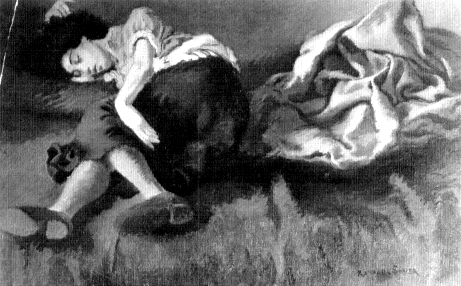
6.13
Raphael Soyer, Girl Asleep , c. 1930. Oil on canvas, 24" × 30". Present location unknown.
play cases and its stable occupants. We are clear about the cordiality of their interchanges and about the ritualized practices in which they engage. The same middle-class viewer might be less sure about Soyer's shopgirls because they are pictured as less secure in their tawdry environment. Since they are outside, they seem, by the standard of Miller's salesladies, to lack a purposeful activity. They interact with us only to invite us to participate in their ambiguous state of transition and to consider the apparently wearying effects of their work.
The transitional setting and the womanliness of the posed studio models in Shop Girls neutralize their economic status as workers. These are the only components of Soyer's pictorial strategy that move in concert with the prevailing ideology of woman's proper place—middle-class, domestic, and family-oriented—particularly as it was perceived in relation to sales work. By the 1920s sales work seemed an ideal job for women—to the feminists who wanted to ensure the right of women to continue working, to social scientists who wanted to reinvigorate homemaking, and to publicists for sales jobs. A particularly strong case for sales work was made by writers who noted its congruence with woman's traditional domestic sphere. Because selling dealt with what people wore or ate or put in their homes, it was, as one observed, "exactly as much a woman's job as housekeeping."[15] Such writers
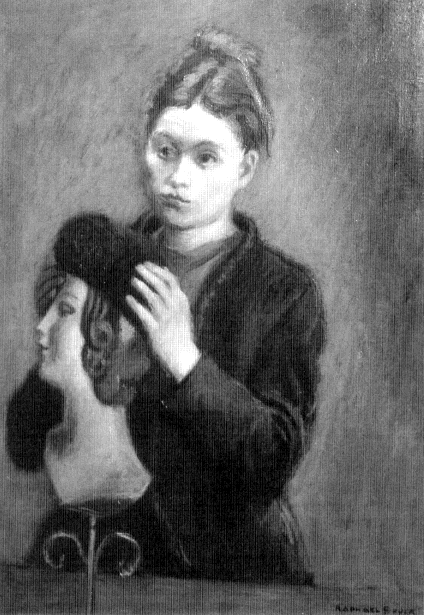
6.14
Raphael Soyer, Milliner , late 1930s. Oil on canvas, 24" × 16". Collection of
Judge Irving Hill.
were recognizing, if not stating, that an already established feminized occupation would continue to pose no threat to the social status quo even if older or married women pursued it.
By serving others or prettifying the workplace, saleswomen like those in Miller's Glove Counter (Fig. 4.25) or Soyer's Milliner (Fig. 6.14) demonstrate the relationship of sales work to woman's sphere. Miller's lady, with a graceful gesture, raises her arm and rearranges her hair with her elegant fingers; the elevated arm reveals the gentle curve made by her breast, waist, and hip. The ease and grace of her pose make her a welcoming figure—the hostess for the guests at her counter as well as an attractive female figure for the viewer—and suggest that her elegance and femininity will accrue to the women who purchase her gloves. Similarly, Soyer's milliner arranges her wares in the otherwise bare setting to make them more attractive. With a vase of flowers instead of the mannequin, this young woman could just as easily be engaged in a traditional domestic task—arranging flowers before the arrival of guests. As workers, both women make things pleasant, comfortable, efficient, or attractive for the shopper. Such womanly workers, represented in a feminized occupation, signaled the movement of private-sector values into the public sphere. They defer—as store managers hoped they would—to superiors or customers as they would to spouses at home. Thus in both images women fit long-standing stereotypes, executing tasks suited to a womanly disposition.
Other writers who celebrated the joys of sales work described it not as an extension of domestic life but as a way to prepare for it:
To the girl who has the perfectly natural and laudable desire to marry someday I would endeavor to show that a few years behind the counter of a big store is a far better preparation for the cares and duties of matrimony than pounding a typewriter or adding columns of figures 8 hours a day. The ability to control oneself in trying situations, which is one of the fruits of selling experience, is in itself a very valuable asset. Such control is based largely on forbearance and what greater factor than that is there in staying happily married.[16]
Even though married and older women entered the work force in increasing numbers in the 1920s, sales jobs were most often filled by young women between school and marriage or by married women who worked until the birth of their first child.[17] Thus both statistically and in popular perceptions these jobs were temporary and less important than other, male, professions. Although retail sales work provided job satisfaction and personal fulfillment—as feminists hoped it would—the department store job itself fit the ideology of women's proper place and did little to disturb the social status quo.
The suspension of Soyer's shopgirls outside the workplace, in transit between environments and observed for their womanly qualities, comes as less of a surprise when we examine contemporary attitudes toward them and their work. Feminine
stereotypes and the perception of sales work as a short-term, dead-end job kept it from being taken seriously as a threat to men's work. The studio poses of Soyer's models and the minimal setting might convey the somber mood of the Depression to a liberal mainstream viewer, but they also reinforce the conservative belief that a woman's appearances and attributes would prove more enduring than the specificities of a job.
The womanliness of these figures, however, particularly when contrasted to that of Miller's, is counteracted by the tawdriness of the setting, the rumpled appearance of the women, their weariness, their anxiety, and their interrogation of the viewer. The differences are rooted in the history of two different stereotypes of women retail sales workers—the shopgirl and the saleslady. Soyer's paintings, which fuse historical and contemporary stereotypes of the shopgirl, encompass the complex issues related to class, femininity, and the working woman in the Depression.
By the 1930s both the shopgirl and the saleslady had well-defined and distinct characteristics. The shopgirl was an older historical type whose social class, educational background, and working conditions had been carefully researched by middle- to upper-class women social reformers in the decade and a half before World War I. Many such reformers, their careful research notwithstanding, filtered their observations through standards of femininity glossed by a moderate version of new womanhood that still insisted on woman's sphere along with new roles in the public arena. Woman, as Mary Maule proclaimed, deserved the rights due her because of her different nature—the "softer, sweeter, tenderer" attributes of womanhood alone. That she could make a valid claim to either marriage or career reflected the ambivalence of many women about managing both. Still, by bringing to light the poor conditions under which the shopgirl labored, these reformers hoped to improve the situation of female workers who were entering the rapidly expanding field of department store sales.[18]
As defined by these writers, the shopgirl was a woman who usually came from a large lower-class family, often immigrants, of limited means. She either lived at home and contributed to the family income or shared cheap tenement lodgings with others similarly employed. At most she would have finished high school. Lacking any specialized training, she turned to sales or to less desirable domestic or factory work.[19]
On the job, the shopgirl was usually a passive attendant rather than an active seller. Management required only that she staff the counter, keep the display in order, and show customers goods on request. Reformers claimed that she worked for subsistence wages for the longest allowable hours in department stores or in small shops that often exploited her so grievously that she occasionally resorted to prostitution to make ends meet.[20] Limited by her class and educational background, she was kept under strict surveillance by supervisors who gave her virtually no opportunity for advancement.
Moral issues aside, reformers concluded overwhelmingly that whether living on her own or at home, the shopgirl worked from economic need and was entitled to better wages. In taking this position, the writers struggled against the belief, held by many employers of wage-earning women, that women worked for extras—for pin money. The pin-money argument flourished on the belief that women lived at home, had fewer expenses, and could make a small wage go further; it never took into account women's differing life situations, nor did it assume that a woman might always work. As early as 1887 one New York City department store employer, asked about the shopgirl's wages and background, summarized the principal tenets of the pin-money argument:
A saleswoman gets about the same right along. Two thirds of the girls here are public-school girls and live at home. You see that makes things pretty easy, for the family pool their earnings and they dress well and live well. We don't take from the poorer class at all. These girls earn from four and a half to eight dollars a week. A few get ten dollars, and they're not likely to do better than that. Forty dollars a month is a fortune to a woman. A man must have his little fling, you know. Women manage better.[21]
When asked why his firm could not pay better so that women might be able to save some money, he replied:
We give as high pay as anybody, and we don't give more because for every girl here there are a dozen waiting to take her place. As to saving, she doesn't want to save. There isn't a girl here that doesn't expect to marry before long, and she puts what she makes on her back, because a fellow naturally goes for the best-looking and best-dressed girl. That's the woman question as I've figured it out, and you'll find it the same everywhere.[22]
Even with substantial evidence to the contrary, particularly for working-class women, the pin-money argument and the perception that women would marry and no longer work persisted. The female sales force shared the sex segregation of their workplace and the sex-based wage differential with millions of women factory workers and professionals.[23] This wage exploitation and the working and living conditions under which she labored became defining features of the shopgirl type. Essentially, she was poor. Because of her precarious economic situation, she was vulnerable to the psychological pressure of store surveillance and solicitation by male patrons. These aspects of her life were often embellished in "true-life" accounts and short stories by O'Henry. Such works transformed her into a minor heroine, sometimes ignoring the conditions under which she worked to admire her fortitude; economic deprivation defined the prewar shopgirl's image and personal courage her persona.
As Benson points out, the "subjective" and "fictional" also shaped the sales-woman—how she was perceived by others and how she thought of herself. In the guise of a romantic cultural heroine, the shopgirl/needlewoman had origins in the French grisette . After becoming a major player in Henri Murger's popular Scènes de la vie de bohème of 1847-49, the impoverished grisette was often portrayed as the attentive, self-sacrificing companion of the social outcast artist or poet. A comfort in financial distress, an inspiration as model and muse, the impoverished shopgirl/grisette willingly stood aside if the artist achieved fame and a higher social station. Documenting her attributes in a 1907 article called "Grisettes and Midi-netres ," Mrs. John Van Vorst observed the passing of both the starving romantic artist of bohemia and the self-effacing grisette. After 1870, the artist became a man of the world, the Baudelairean flaneur who associated with women of his own bourgeois class. And the shopgirl of the new generation, Van Vorst claimed in observing the outpouring of social commentary, had become a cause less "for poetic inspiration than for sociological research . . . [T]he touching poetry of the grisette has been transformed into the problematic realism of the midinette ." Van Vorst, once a factory mill worker, wrote of the difficult life of the contemporary shopgirl:
So the grisette has disappeared, and in her place we have the more practical, more prosaic, more modern, and more to be pitied little working-girl, to whom has been given also a nickname which in itself suggests the nature of her existence. She is called the midinette (little noon girl). From twelve to one-o'clock this laborer has the hour of freedom which counts to the extent of submerging in forgetfulness the ten other working hours of the day.[24]
In her article Van Vorst looked at the contemporary French midinette —for her, any worker in the fashion/needle trade—to draw parallels with the American worker. Rather than adopting the muckraking stance of many of her contemporaries, Van Vorst found virtues of "self-sacrifice, endurance and heroism" in the midinette's ability to manage a tiny wage. This young woman, she argued, took pleasure in self-sufficiency and in the pursuit of love, playing the "coquette" to make her conquest.[25] While Van Vorst celebrated the midinette for her gentle nature, she also mourned the demise of the passive and devoted ideal of womanhood embodied in the grisette. For her the grisette was the working-class version of the steel-engraving lady, set against the new woman as Gibson girl in Caroline Ticknor's 1902 piece contrasting traditional and modern womanhood.
Van Vorst's two working-girl types relate to Soyer's shopgirls. Soyer's fascination with Degas's nineteenth-century working women—among them milliners—extended to his own depiction of a solitary milliner, the adoption of millinery store fronts for many of his outdoor scenes featuring women, and his original title for the work now called Lunch Hour: Fourteenth Street Midinettes . More important, perhaps, is what may be read in these works as the conjunction of the "problematic
realism" of the socially downtrodden midinette , to evoke rather than describe the hardship of female labor in the Depression, and the more melancholy figure of the working girl as artist's model.
When asked about the struggles he experienced in his choice of career, Soyer acknowledged that "it was a very romantic idea to be an artist," suggesting his willing acceptance of bohemian life, with the studio at its center. Soyer included himself in a community of fellow artists, many of whom he honored by making them subjects of his paintings beginning in the mid-1930s. He "talked to himself" frequently through the self-portraits that chronicled not just his changing appearance but his changing professional status or sense of the artist type. His relationship to his models was one of close friendship, respect, and mutual endeavor rather than sexual liaison; in this Soyer models were unlike their self-sacrificing predecessors. They were women largely from his own social class or bohemian milieu, with similar interests in art, literature, dance, or drama. Soyer always felt he inscribed himself somewhere in his work and identified with his models and with the unemployed; both, like artists, were social outcasts. This identification is visible, I would argue, in the parallels between his melancholy images of himself—one as the blue-shirted, smoking Depression era worker (Fig. 6.15)—and his portrayals of models as fellow workers with the same hollow-eyed serious mien. In effect Soyer adopted and transformed the grisette and the somewhat newer midinette to make his shopgirl resonate within the accepted discourse of art and society in the 1930s. It was a discourse he drew on as a member of the community of socially conscious artists in the Depression.[26]
In the prewar period, reformers used the term shopgirl interchangeably with saleswoman because most of these workers were from similar socio-economic backgrounds. Moreover, they used the term compassionately to refer to an impoverished retail sales worker. By the 1920s, when Miller and then Soyer began to paint urban life, the terms were no longer interchangeable. The shopgirl was still perceived as a poorly educated woman from a lower-class background, but store managers and employment counselors gave less focus to the conditions of her job, invoking instead the new model of success. The saleswoman was now characterized as a department store professional, often middle-class and college educated, sometimes married, and not always young.[27] In addition, the saleslady became the "improved" shopgirl, one who through education and retraining could better her position. By showing the shopgirl fatigued and in transit, Soyer takes a compassionate view of her historical plight as hard-working and exploited. And unlike Miller, who only depicts the saleslady, Soyer refuses to acknowledge what many boosters of the new department store sales staff wanted everyone to believe—that all store workers, thanks to benefits and training, shared an equal opportunity.
Several institutional, social, and economic changes since the prewar period help to account for the sharper division between the shopgirl and the saleslady. By the

6.15
Raphael Soyer, Self-Portrait , 1930s. Oil on canvas, 16" × 14".
Present location unknown.
1920s the urban department store had expanded into a business with all the respectability of a bank or an insurance company. As the historian Frederick Lewis Allen observed, retail sales work became a highly desirable occupation for a new class of woman.
Up to this time girls of the middle classes who had wanted to "do something" had been largely restricted to school-teaching, social-service work, nursing, stenography, and clerical work in business houses. . .. In 1920 the department store was in the mind of the average college girl a rather bourgeois institution which employed "poor shop girls;" by the end of the decade college girls were standing in line for openings in the misses' sports-wear department and even selling behind the counter in the hope that some day fortune might smile upon them and make them buyers or stylists.[28]
Adding to the new respectability was a substantial improvement in wages and working conditions in New York stores for all members of the sales staff. Starting salaries, once as low as three dollars, were ten to sixteen dollars per week plus commissions. Hours were usually nine to five-thirty, and most store workers had morning and afternoon breaks in addition to an hour for lunch. A number of stores closed on several summer Saturdays, and after a year of work employees received a week of paid vacation. Large department stores had medical staffs, mutual-aid associations, and elaborate training programs for employees.[29] In the prosperous 1920s some of the wealthiest stores had country retreats where employees could spend a restful week of vacation. To judge from the literature on department stores and their employment opportunities as well as the contented appearance of Miller's salesladies, the days of the struggling shopgirl were long gone.
In her 1929 study The Saleslady the sociologist Frances Donovan initially corroborated these perceptions. She interviewed an older saleswoman who stated that it was no longer a disgrace to work in a department store and that the shopgirl attitude was dead. The woman explained that she was now treated well, and that she no longer feared either her customers or the floor manager. Donovan also noted that both European and American stores were adopting terms like co-worker or store associate to replace shopgirl , which had become in some store owners' minds "an epitaph [epithet]" of "disrespect."[30]
Management's "disrespect," unlike the "sympathy" of Progressive Era reformers, resulted from a class- and gender-based discourse, through which management claimed that lower-class, poorly educated shopgirls could not successfully sell to the middle- or upper-middle-class clientele they sought to attract. Salespeople, as one store manager reported, "frequently speak and act in ways which do not commend them to people of refinement."[31] By the teens and 1920s, store executives decided that a cordial and well-informed sales staff might improve profits. They embarked on programs to raise the educational level of their workers and professionalize the sales staff—in short to eradicate some of the class discrepancies between workers and customers and between members of the sales staff.
Welfare programs, ostensibly designed to improve the overall well-being of store workers, served management as well. (Later, such programs were given the more neutral designation "personnel work" to avoid charges of paternalism). Lunch-rooms, medical programs, libraries, and personal-improvement classes made for happier workers, prevented union organization, and created an improved environment for socially conscious shoppers who might take management to task for mistreating working women. Store managers also knew that a decent standard of living would contribute to staff morale. Consequently, they included commissions in the wage system and discounts on store merchandise so that women employees could dress well.[32]
Training programs promised to transform the staff from a passive to an active, pleasant, and efficient sales force. In the 1920s stores instituted a series of such programs to help salespeople learn everything from filling out sales checks to "skilled selling," which meant an education in good taste, "improved standards of living, better habits of thought, higher interpretations and ideals."[33] Such an education would ensure that a saleswoman's class identity approached, at least superficially, that of her clients. Management also encouraged women to capitalize on qualities long recognized as womanly. The capacity to respond sympathetically to other women (and hence manipulate them) and to understand all things domestic became a key ingredient in the saleswoman's training. Sales training capitalized on women's gender identity by reinforcing the belief that women were natural consumers.[34] The results of this training are depicted in a work like Miller's Department Store Shoppers (Fig. 4.27), in which two women with equal expertise confer on yard goods for the home. The saleswoman, neatly dressed in the neutral attire worn by all the sales staff, exhibits both her respect for her client and the authority that comes from all the learned and instinctive responses of "skilled selling." Furthermore, Miller's use of an idealized matronly type for both seller and buyer blurs the signs of class distinctions between them.
Finally, along with reeducating the lower-class store worker and providing her with both welfare and financial incentives and promotion opportunities, management actively sought a new kind of saleswoman. Many applicants for sales positions were required to take aptitude and psychological tests. Stores sent representatives to women's colleges to recruit graduates from "good educational and social back-grounds—social in the sense of environment"—for sales training and management programs.[35] A number of stores also had visiting "squads" of college students who would work in all departments over a period of several months to get a feel for the entire store operation. The journalist Helen Law reported on one store executive for whom "the orderly mind which college education gives is a valuable asset." Along with colleges, several new schools of retailing provided well-trained candidates for sales jobs.[36]
In spite of the apparent favoritism shown in hiring the middle-class college-educated saleswoman over the old-style shopgirl, many store owners still held that the best sales force was "cheap help cheaply paid," that is, one that management could mold to its own practices.[37] No matter what its actual hiring policies and wage scales, however, management was quick to assure the public of the democratic makeup of its sales force. Samuel Reyburn, the president of Lord & Taylor in New York, explained in a 1930 speech to the National Retail Dry Goods Association:
We don't prefer the college or theoretically trained woman and we don't prefer the practically trained woman in collecting the material out of which we build this organi-
zation. We want both of them, and after we get them we want each to forget the class consciousness that she indulges herself in, in appreciation of her particular training. College-trained men and women are often a little bit too proud of the fact that they have that certificate—and many practically trained people I know, on the other hand, are just as egotistical and conceited about their training. Both of these classes of people have something to contribute.[38]
Practically speaking, however, there was a selective hiring process, and tensions existed between groups from different social and educational backgrounds in department stores. Frances Donovan, an attractive college-educated woman who went undercover to look for a sales job for her sociological study The Saleslady , was immediately hired over other applicants with sales experience because of her appearance and education.[39]
Donovan observed a natural camaraderie among saleswomen of all backgrounds that ended with the working day.[40] She also witnessed the arrogance of college students in management programs, pointing out precisely what Mr. Reyburn claimed the stores would avoid.[41] She came to understand, through sometimes touching interactions with her co-workers, what other writers also observed. Certain types of lower-class women were less visible in the stores than in earlier times. When they were part of the staff, they had little chance to advance in what were, by the 1920s, middle- to upper-middle-class stores whose management claimed to employ a better class of workers and not shopgirls. In Philadelphia, John Wanamaker refused to hear staff members referred to as shopgirls or help, arguing instead that men and women in his store exemplified the dignity and respectability of labor.[42]
The image of the professionalized department store saleswoman received substantial press in the 1920s because it satisfied the needs of several groups in and outside the stores. Gender aside, this saleswoman was a model of success, getting ahead in an era that valued business achievement. Articles describing her and her work stressed opportunities for quick advancement, dangled five- to ten-thousand-dollar per year executive salaries before readers, and reveled in the statistic that 50 percent of executive positions were held by women. In this context, retail sales work was exciting because it promised money, power, and status. But such success was not the norm, and the smoothly run sales process was often jarred by colliding class and gender interactions. Male managers who sought control over female sales-women through training had little control over the actual process of selling; sales tactics developed by a cohesive department of women on the sales floor often sabotaged a trainer's best efforts. But such tactics could also produce effective sales, thereby undermining managerial authority. The desire of managers and customers for a well-trained and authoritative female sales staff collided with their desire for a deferential one.[43]
The rhetoric of success and professionalism surrounding this evolving saleswoman stereotype resembled that of feminists who argued for women's right to work, to be independent, and to achieve personal satisfaction; in both instances it served a narrow middle-class end.[44] It ignored the lower-class women who continued to work in factories, dime store sales jobs, small specialty stores, and Fourteenth Street bargain stores throughout the 1920s and 1930s. These women worked from economic need rather than for personal fulfillment or for pin money. The shopgirl had not disappeared, in spite of improvements in department store life and intensive training programs. She had been made invisible by an ideology of progress and personal success that celebrated the possibilities for the dominant middle class in the 1920s.
Some of the rhetoric shaping the discourse on women in the sales force appears in Fourteenth Street School paintings of the 1930s. A comparison between Soyer's Milliner of the late 1930s (Fig. 6.14) and Miller's Glove Counter of the same period (Fig. 4.25) makes it clear that Miller painted the new model of professionalism and achievement—the successful middle-class saleswoman—whereas Soyer painted the poorer shopgirl. Miller's saleswoman is confidently poised behind her counter of goods, whose plenty, like the grandeur of the department store space opening before her, signifies prosperity. Though young, she is mature; she wears the typical plain dress of the department store saleswoman, like Ohrbach's saleslady Miss Clara Mayer (Fig. 6.16).[45] Soyer's milliner, like his shopgirls, offers a striking contrast. She appears considerably younger. Dressed in a bulky jacket and a blouse with a wrinkled collar, she works with a single object in a bare interior. Coarsely brushed surfaces emphasize the setting's drabness, the shallow space its confinement. Everything in her appearance and surroundings indicates a subsistence wage that leaves little for pretty clothes or entertainment to brighten her spirits. She has no customers or co-workers. Her serious demeanor suggests that she is conscientious about her work—that she is worthy of both respect for her efforts and recognition of her difficult working surroundings and the isolation of her working life.
Miller's images embody action, interaction, and business. The saleswomen are at one with the prevailing middle-class ideology of woman's proper place—and fall within the discourse of a revised new womanhood. In comfortable department store interiors, they work and behave in the womanly ways that are expected of them and bring them success. Through the image of this professionalized worker Miller's paintings avoided the harsher conditions of working-class life and the inequities of gender ideology and muted such problems with the cheerful trappings of prosperity. Soyer's works confronted both by focusing on the historically hardworking shopgirl.
Paintings by Miller and Soyer belong to representational discourses on women and modern commerce that originated in the nineteenth century in works com-modifying women by relating them to the display of goods for sale. In James Tissot's
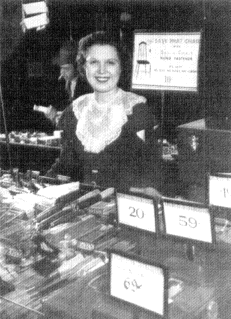
6.16
Photograph of Miss Clara Mayer, "The
American Shopgirl," from "Women in
Business II," Fortune 12 (August 1935), p.
85.
Milliner's Shop (Fig. 6.17), as in Miller's Glove Counter , a young woman is a welcoming figure in an elegant boutique—as decorative as the ribbons and fabrics that surround her. Another woman, off to the left, becomes an available part of the display as a gentleman looking through the store window divides his admiring gaze between her and the goods. It was part of her womanly role to be admired, and, given the perception of sexual availability attached to the nineteenth-century milliner's occupation in France, even eventually acquired. Working women were part of a traffic in signs of modern life—and were available for ready visual consumption, if not for purchase. Degas's solitary milliner in The Millinery Shop (Fig. 6.18) works on finishing a hat, pins held between her lips as she appraises her work. In a plain setting she works beneath a colorful array of hats, none of which she actually wears. Her pose as she turns away from the finished product suggests her inability to acquire the beautiful hats that are available to the elevated buyer or viewer. Moreover, her absorption in her work belies to some degree the rhetoric of sexual availability attached to the milliner. Like Soyer, who succeeded him, Degas subtly evoked the inconsistencies of what the nineteenth-century critic George Moore called "the sweet, sad poetry of female labor."[46]
Apart from features he appropriated from Degas, Soyer's pictorial rhetoric—specifically the bare settings and the ennui of his figures—is close to that of periodicals like the New Masses that published images of the shopgirl. Throughout the
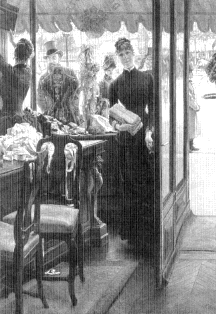
6.17
James Tissot, The Milliner's Shop (La
Demoiselle de magasin) , 1883-85. Oil on
canvas, 57" × 40". Art Gallery of Ontario,
Toronto.
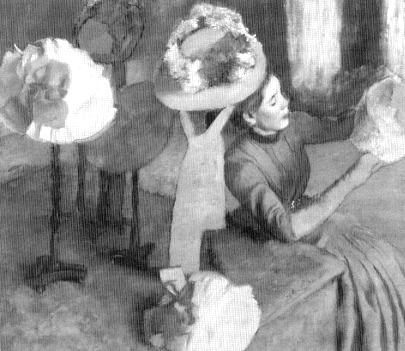
6.18
Edgar Degas, The Millinery Shop , 1879-84. Oil on canvas, 39" × 43". The
Art Institute of Chicago. Mr. and Mrs. Lewis Larned Coburn Memorial
Collection.
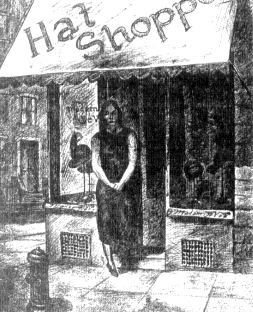
6.19
F. S. Hynd, "Mid-Afternoon," New Masses 1
(May 1926), p. 27.
1920s, artists producing cartoons for this publication recognized that salesgirls in poorer establishments continued to have dreary lives. In a May 1926 drawing from the New Masses entitled "Mid-Afternoon" (Fig. 6.19) the shopgirl stands idle and alone in front of a tiny hat store on a deserted street, far from the bustle and glitter of Fifth Avenue. In "Sunday Morning" (Fig. 6.20), another New Masses cartoon, from December 1931, the wage-earning woman performs the Sunday ritual of doing her laundry to prepare for another week of work, the burden of which is expressed in the tired curve of her bent back and her lowered eyes. These images, at least in their sobriety of mood, differ from John Sloan's images of working women from earlier decades. Whether returning home from work (Fig. 3.21) or performing their own outdoor toilettes on Sunday morning (Fig. 1.9), Sloan's women are represented as exuberant and happy. They take pleasure in their freedom and sensuality as well as providing it for the viewer. Though Soyer's paintings lack the narrative specificity of either Sloan's paintings or the cartoons, they share with the earlier works a rough fluidity in the application of paint that by the 1930s, combined with lower-class subjects, had become an index of socially concerned art.
I have been tracing the historical development of two stereotypes of women working in retail sales to show how Miller depicted the successful middle-class saleswoman, Soyer the weary, anxious lower-class shopgirl. Both artists, however,
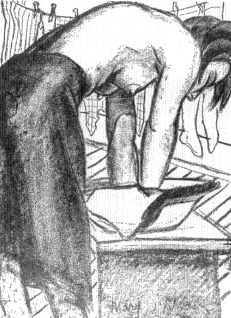
6.20
Mary O. Johnson, "Sunday Morning," New
Masses 7 (December 1931), p. 14.
portrayed retail sales clerks during the Depression. What vision was shaped by their pictures? How do their strategies relate to specific conditions of the 1930s—the employment picture in and around Union Square and changes in the discourse of new womanhood as the working women assumed a larger role?
Unemployment was the central anxiety of the 1930s. To judge from the pictorial record of all the Fourteenth Street artists, it was a male rather than a female problem. With the exception of Miller, who never painted unemployed men, Marsh, Bishop, and especially Soyer all contributed to the iconography of the Depression era's most compelling image of despair—the jobless man. They pictured these men—on Union Square, in breadlines, and in scenes of Bowery dereliction—in somber browns and blacks. Where Marsh pressed men together to show their endless numbers and collective despair, Soyer and Bishop portrayed only a few at a time and individualized their ennui. In Soyer's In the City Park (Fig. 3.41), a scene of perpetual waiting, three despondent men crowd together on a park bench in Union Square. As in Shop Girls , however, Soyer placed the brightly illuminated individualized faces of the unemployed men close to the viewer so that we cannot avoid seeing their boredom and despair.
In representing the unemployed male, the Fourteenth Street School artists painted the historically acknowledged and accepted victim of the Depression economy. But the situation was almost as bad for women. Although only 25 percent of the total
American work force were women, they made up one-third of the total unemployed. And 23 percent of New York women were out of work by early 1934. By mid-decade, the employment picture for saleswomen was more serious than for any other low-level white-collar position. In New York, more than 50 percent of the saleswomen, the lowest paid of all women professionals to begin with, reported a 50 percent drop in earnings. No economic aid for them was forthcoming.[47] The proportion of public relief funding allocated for women did not match the proportion of unemployed women in the work force, and aid efforts were usually concentrated on male heads of families. Female unemployment, moreover, received little publicity, even though the suffering of unemployed women was similar to that of men. Like men, they felt personally responsible for the loss of jobs, their appetites deteriorated, and they wandered about aimlessly or hid in their rooms. Yet few of them applied for relief; of five hundred early applicants for New York City funds, for example, only ten were women. There were no large-scale institutions for women's relief and no public flophouses. Women seldom joined breadlines. In the struggle to make ends meet, many took domestic posts or resorted to peddling apples or pretzels, often on Union Square. When totally destitute, many simply approached men who would take them in.[48] The anxious and weary appearance of Soyer's shopgirls was understandable given the conditions of existence for many 1930s salesclerks.
There are no images of unemployed Fourteenth Street women for two principal reasons: these women were less visible than their male counterparts, and their unemployment was not as significant a public issue. Moreover, the Fourteenth Street neighborhood was filled with shoppers and women who worked in stores or offices—it was a neighborhood of active women who, even if not gainfully employed outside the home, were involved in what the district offered.[49]
Indirectly, however, Soyer addressed the issue of women's unemployment. The women in his Shop Girls , in their transitional state, are never stable or secure in the working world. Furthermore, Soyer's other images of women in the Depression, unlike Miller's, show studio interiors in which women wait patiently with nothing to do because they have no work and nowhere else to go (Figs. 5.12, 6.11, and 6.13). In its theme and in the poses of its figures Solitaire (1934; Fig. 6.21) alludes to the issues of gender and unemployment that became acute in the Depression. A seated female figure in an unbuttoned skirt, her breasts half-revealed to the viewer by a loose chemise, plays cards while an anonymous male companion lies behind her, facing the wall, his back to the viewer. The contrast between her upright and his recumbent pose, between her identity and his nonidentity, between her card playing and his inertia suggests the solitude and isolation of each. But she is the more sexually available and attendant while he turns away, figuring shame in his posture—at his failure to work or to perform sexually, both failures of masculinity described by social commentators throughout the Depression. Whatever the mean-
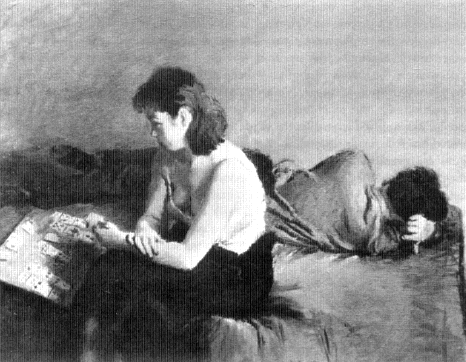
6.21
Raphael Soyer, Solitaire , 1934. Oil on canvas, 22" × 28". Private collection.
ing of a work like Solitaire , Soyer, in many of these images, gives lower-class, unoccupied women, who were otherwise out of public view, a place of recognition in his art. They are the counterparts of his weary shopgirls in the same way that Miller's active shoppers are counterparts of the saleswomen. In this context, Soyer's imagery has, as social documentation, a greater consciousness of the plight of the unemployed woman in the Depression.
The tension, anxiety, and constriction in Soyer's Shop Girls reflect both the unemployment that continually threatened salesclerks in bargain institutions and the conditions of the jobs themselves. Not only were these the lowest paid of all white-collar jobs for women, but also, in the cheaper stores, hours were long. Many clerks, on their feet for hours, suffered from flat feet, varicose veins, inflamed joints, nervous irritability, and anemia. For fear of losing their jobs, women refused to use the stools behind the counter that were required by law.[50] And surveillance by superiors continued to be a problem. One girl who took a job at a five-and-dime
reported, "I had a grotesque consciousness of secret, unknown eyes on me—watching my every movement from some unseen vantage point."[51]
By 1934 the New Deal's NRA (National Recovery Administration) codes had appeared, intended to alleviate some of the wage problems. Fourteenth Street stores like Klein's and Ohrbach's were now required to pay a minimum wage of fourteen dollars per week (up from a low of about seven). Unfortunately, the codes were difficult to enforce, and stores regularly ignored them or found ways to circumvent them.[52]
Examples of the exploitation Soyer's shopgirls might have experienced come from 1930s sources exposing practices at Klein's. The evidence is particularly disturbing because Samuel Klein actively promoted the NRA codes in mercantile circles. Furthermore, he was widely acclaimed in newspaper and magazine stories for his Horatio Alger-like rise to wealth and commercial success and for his personal beneficence toward workers, to whom he gave annual Christmas bonuses.[53]
Having initially praised the new codes, Klein made several attempts to avoid them. In November 1933, he petitioned the NRA to reduce the minimum wage he paid from fourteen dollars per week to twelve. Prior to the NRA codes, Klein's wages had ranged from six to eight dollars per week. When his plea was refused in both New York and Washington, Klein said he would be forced to abandon the straight five-day week and operate under schedule C of the retail code, which provided for a forty-eight hour six-day week at fifteen dollars per week. He also stated that the denial of his plea would add $300,000 to his annual wage budget—this from a man who did a $25-million business and whose personal annual income in the middle of the Depression was $1 million.[54]
The most telling evidence of what life was like for a Fourteenth Street shopgirl comes from Stella Ormsby's account of her job at Klein's. Ormsby wrote "The Other Side of the Profile" for the New Republic in 1932 in response to a glowing story about Klein that had appeared in the New Yorker . She worked in the basement of Klein's, the site of the best bargains, with dresses selling for about two dollars. Soyer's empathetic image of tired, bleary-eyed, and rumpled shopgirls takes on a new resonance alongside Ormsby's account of her day.
The basement is a long winding, angular affair, calling to mind the Times Square subway station. . .. Every day between two and three thousand people find their way into this cellar, which is low-ceilinged and without windows. The unwholesome air alone makes it an ordeal to remain down below for more than an hour. The few electric fans are absolutely ineffectual to counteract the heat and smell of sweat.
My hours are from nine-thirty in the morning until seven in the evening, including Saturday, and my job consists in trailing customers and readjusting dresses they throw down from the racks. The work is so deadly monotonous that it would try the patience of a moron. I walk many hours a day in performing my job, and what with the rush and crush of the milling crowds, the foul air and the noise and the bawlings out from
the supervisors, I find myself at the end of the day in a state of utter exhaustion. I get home brutally worn out with barely sufficient strength to eat my supper and get to bed to regain enough vitality for the next day's grind. My weekly salary is eight dollars handed to me in an envelope which cautions me to resolve to make "payday savings that future days may be happy days."[55]
Ormsby went on to describe the difficulty she had in getting a job and the shady practices under which she suspected she had been hired. Her description of Klein's search for cheaper labor is echoed in his petition to the NRA for a lower wage in 1933:
It was only after five months of persistent hunting for work that I landed my present job. Several weeks ago, an advertisement in one of the daily newspapers announc[ed] that Klein's would hire new help. With over three hundred other girls, I was on the premises two hours before the stipulated time. The employment manager lined us all up and went through the line selecting a girl here and a girl there in what seemed to me a wholly arbitrary fashion. Fifty were selected and the rest told to leave. After two days of red tape—physical examination, references, credentials and lecturing, the purpose of the last being to whoop up pride and enthusiasm in us for the Klein establishment—I was finally "trained" for my job. I soon learned from the older girls that the reason for the "new" help was that the girls whom he had displaced were receiving ten dollars per week and that they were all discharged in favor of the new group who were getting only eight. How true this is I cannot say. But it is the sort of thing anyone working in the basement would find it hard not to believe. Also that the girls hired after my group are getting seven and seven-fifty would seem to indicate that that is what happened.[56]
Klein was later accused by an NRA representative of discharging employees for having union affiliations. While Klein claimed that layoffs were seasonal (because his store sold no gifts, Christmas season was always slack), a report by the NRA official found him in violation for "a systematic, deliberate, all-embracing scheme to thwart the workers' rights to self-organization," including a store-wide system to prevent employees from joining a union. Klein accused the New York NRA of "breeding communism." Workers who had been laid off continued to picket Klein's until February 1935, when Klein settled with them and agreed to put them on a preferential list for rehiring.[57]
Artists and writers were both witnesses of the period of labor unrest on Union Square and participants in it. Continuing through March 1935, there were daily pickets and a series of large-scale Saturday demonstrations in front of Ohrbach's.[58] The facts of the strike were captured in Regional Marsh's 1936 painting End of the Fourteenth Street Crosstown Line (Fig. 6.22). Behind the laborers taking up the old trolley car line, store workers picket Ohrbach's for the store's failure to unionize.[59]
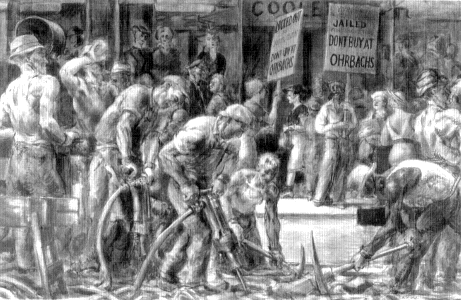
6.22
Reginald Marsh, End of the Fourteenth Street Crosstown Line , 1936. Tempera on
board, 23 3/4" × 35 7/8". The Pennsylvania Academy of the Fine Arts, Philadelphia.
By 1936, when Soyer painted Shop Girls , Klein's and Ohrbach's had been forced into greater leniency toward union representation, thanks in part to the four steady months of picketing and conflict. Soyer would have witnessed these events just before beginning the painting. Though less explicit and overtly documentary than Marsh's work, Soyer's painting Shop Girls portrays some of the hardship attendant on poor working conditions and uneasy management-worker relations. The compositional proximity of these tired women to the viewer makes the truth more blunt. The gesture toward her fellow workers of the shopgirl who confronts the viewer can be read as a worker pointing to signs of workplace unrest. Through her upturned palm she not only questions the observer about the conditions in which she and her co-workers find themselves but also quietly asserts herself.
Apart from unemployment pressures and the hardships she encountered in the workplace, a 1930s shopgirl, like other working women, was subject to changing attitudes about women in the workplace. Even though her feminized occupation remained acceptable for both young and older women—like those Miller depicted as saleswomen—a growing sentiment against married women in the work force affected all discussions of working women.[60]
Feminist arguments about women's right to work became hollow when the Depression struck and thousands of male heads of families lost their jobs. Advocates of working wives had spoken only to a small middle-class audience, ignoring the needs of married working-class women. Because these advocates understated economic motivations by emphasizing women's need for personal fulfillment—a central feature in the discourse of new womanhood—they only reinforced the notion already popular among proponents of the ideology of women's proper place—that women worked for pin money and personal satisfaction rather than from economic need.[61] The unfortunate persistence of this argument, even when statistical evidence pointed in the opposite direction, contributed to a growing sentiment against working wives just when many needed their jobs, indicating that the pin-money claim provided an easy justification for an underlying desire to remove all married women from the work force.[62]
Public sentiment against working wives ran so high during the Depression that it diffused all attempts to assert any woman's right to work.[63] To combat some of the employment problems, feminists and job counselors adopted a series of defensive strategies, not only to help women maintain their jobs but to help them find jobs as well. These writers and speakers now insisted that all women worked from economic need rather than for self-fulfillment or from personal ambition. Some even restated the old claim that women would prefer not to work at all because they valued home life over any job. Furthermore, employment advisors increasingly urged young unmarried women to consider sales or clerical positions where they could avoid competing with men.[64] The jobs themselves became vehicles for reasserting the ideology of women's proper place. Finally, in the middle of the decade, when writers on occupational trends noticed that employers emphasized the appearance and personality of a job candidate over her qualifications—a distinction from the 1920s—job counselors encouraged women to reassert their beauty and womanly charms and be aware of their secondary and temporary role. All these strategies neutralized previous arguments about working women and reinforced the ideology of woman's proper place.
In many of the Fourteenth Street paintings some form of attractiveness, prettiness, or glamour defines working and shopping women. A saleswoman's prettiness, whether consciously intended by the painter or not, also represented the way women workers were expected to look and behave. Contemporary critics who spoke favorably of Soyer's work, however, described his women by character rather than appearance as honest, humane, and sincere. Carl Zigrosser, who found this type of woman at concerts and meetings, felt she was "peculiar to the big city in the 1930s. . .. a working girl, not a debutante, sometimes sturdy, sometimes with a wistful charm, always self-reliant, never the automaton of the mass, always with some spark of individuality glowing within her."[65] Critics who were less positive considered Soyer's women drab, unhappy, and, more to the point, either lower
class and not beautiful or, later, "lower-class beauties."[66] Beauty, as a standard quality critics responded to in Soyer's work, resided in the paint and poses of the figures—the artist's traditional means of defining women as attractive in a work of art. In Shop Girls , for example, the women's brightly colored or partially transparent blouses reveal full curving figures. Three women wear bright lipstick. Compared with the palette of Shop Girls , that of Soyer's images of unemployed men (for example, Fig. 3-41) is duller. In addition, the artist placed his male models in slouched and disconsolate poses; the women's attitudes are generally more upright and more appealing. Fundamentally, Soyer's use of studio conventions inscribes in these figures not beauty per se but one kind of femininity observed during the Depression.[67] This quality helped to make working-class women an acceptable subject of American Scene realism; the same quality also served to express the womanly ideology which permeated the salesgirl's job in the 1930s.
Though gently sexualized by studio poses, Soyer's working women remain more anxious than alluring, in contrast to some of Miller's saleswomen. The clerk with her back to the viewer in Glove Counter and the clerk to the right in Saleswomen (Figs. 4.25 and 6.12) assume the provocative pose typical of movie stars' publicity photographs (Fig. 4.7). Marsh's standards of beauty for women, bewitching glamour and charm, appear in their most extreme form in his Hudson Bay Fur Company , a work that depicts a regular Union Square event (Fig. 3.26). Alfred Kazin tells how crowds in the thirties gathered daily to watch the live fur models, "gawking" at them as they circled "round and round like burlesque queens" in a lighted corner window two stories above the square.[68] Marsh placed viewers below the central model so that they look up at the store window as if at a burlesque stage and take advantage of the strip-tease pose. In this tawdry corner of Union Square, working saleswomen become objects of delectation.[69] Marsh captured the sexual exploitation in the ideology of woman's proper place—the suggestion that women's sexuality would help them keep their jobs.
Because of job scarcity, this ideology, which had served to maintain the social stability of the nuclear family in the 1920s, now took on a larger economic meaning. It exercised more rigid control over women's lives in the 1930s—even those of women holding socially acceptable sales or clerical jobs. Marsh's photograph of the Hudson Bay Fur Company (Fig. 3.27) shows how distant the store model actually was from the sidewalk spectator and how Marsh transformed and sexualized her. The photograph also suggests that the store window was an unpleasant working environment, with cramped space and bright lights. Such unpleasantness was a fact of life in many of the retail establishments around Union Square.
The term shopgirl by the 1920s described a lower-class store worker who was given little respect or responsibility in an enterprise. Historically it also signified a working woman who suffered under the conditions of her work, unlike the saleswoman, who was a model of success. By choosing this shopgirl type and showing
her fatigued, Soyer revealed the effects of her working existence on Fourteenth Street and focused attention on her life in the Depression. By showing her in transit, young and feminine, he reinforced the ideology of woman's proper place that considered her occupation temporary. Crucial to the multivalence of the work is the tension in which these features are held. Shop Girls disrupts the discourse of femininity by intersecting it with one of class and labor. Shopgirls had to work to survive and were thus alienated from an ideology that claimed their economic efforts were temporary and for "extras." They are also alienated from work that exploits them as women. Whether or not it was his intent, Soyer expressed that alienation by suspending them outside both the workplace and the domestic environment and by having them interrogate the viewer and ultimately the social order that sustained the conditions of their labor. Soyer's image embodies the contradictions and complexities of the ideology and of working women's situations during the Depression.
Raphael Soyer, one reviewer wrote, "tells a story of his own people, and naturally this sympathetic approach to his sitters renders his work all the more communicating."[70] Numerous reviewers echoed this environmentalist assumption of American Scene painting—that a realism created from the artist's own milieu was the most authentic art. Indeed, Soyer's early life and working experiences would have heightened his empathy for workers laboring under poor conditions for meager pay. Through his own experience, in his own marriage and family, and his observation of his models, Soyer was well acquainted with the problems of working women and with the importance of their right to work. He would have understood that lower-class immigrant women worked from economic need rather than for personal fulfillment. Through the 1920s, while he studied art and struggled with his early work, he himself endured firsthand the hardships of the hourly wage earner, an experience other Fourteenth Street artists never had.
Even more interesting in the contemporary reviews of Soyer's work is their negative response to lower-class femininity. Reviewers, consciously or not, used language that reduced women to lower forms of life or made them helpless. But because of the high quality of his art, they either forgave the painter for such flaws or saw the power of his depictions. Emily Genauer, who spoke of his "drab, unhappy and drooping" models, described his shopgirls as "pathetic." In Office Girls (Fig. 6.3), painted as a pendant in the same year as Shop Girls , the women were, according to one reviewer, "not particularly enticing," being "thin, wiry, alert . . . still showing the nervous strain of their days." Even though these women were "the mainstay of our commerce," this reviewer felt that their work undermined their femininity. One of the most revealing descriptions came when Soyer's Gittel (Fig. 6.23) won the award for the best portrait in oil at the Pennsylvania Academy's 1934 annual exhibit. Though Soyer himself characterized Gittel as a brilliant woman of ambition—a poet and singer—the Art Digest reviewer saw Gittel as the "essence of
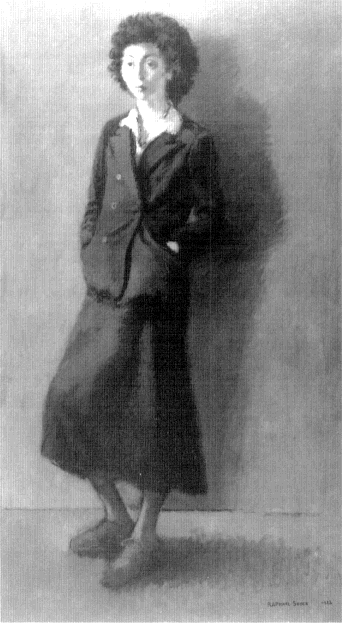
6.23
Raphael Soyer, Gittel , 1932. Oil on canvas, 49 1/2" × 27 1/4". The
Regis Collection, Minneapolis, Minnesota.
piquant feminine undernourishment, a frail drab little thing in genteel rags." Indeed, the reviewer noted that Soyer's women were merely "creatures . . . delicate questioning souls in a world with little sunshine or happiness" (italics mine). But, he concluded, Gittel was "diabolically well-painted." Another reviewer, a year later, observed Soyer's potential but noted, "Technical facility is always a source of danger, and when it is allied with a powerful gift for depicting types it becomes a positive menace." Art could make class more powerful (and more threatening).[71]
Soyer's consciousness of issues of class and his concern about the exploitation of workers accompanied a heightened quality of what both critics and Soyer himself called naturalism. Along with his more traditional training and sources, Soyer developed both his sense of urban realism and its relation to social, cultural, and political issues through regular attendance at John Reed Club debates, the Artists' Union, and later the Artists' Congress. Soyer's principal motives for these activities were his pressing need both for a community of fellow artists—he wanted a way out of his self-involvement, and these activities became vital to his personal growth—and, more important for analyzing works like Shop Girls , for a greater sophistication about social and political events. He wanted to raise his consciousness, and he believed then and throughout his career that an awareness of such issues gave psychological depth to his paintings.[72]
Soyer was always reluctant to acknowledge the politics and ideology of his pictorial strategies, particularly in works of the mid-1930s:
The John Reed Club of Writers and Artists helped me to acquire a progressive world view, but I did not let it change my art, which never became politically slanted. I painted what I knew and what I saw around me—many pictures of the unemployed, of homeless men, because I saw them everywhere, in parks, on sidewalks, sleeping on girders of abandoned construction sites. I sympathized with them, identified with them.[73]
In Soyer's view Shop Girls would have been "politically slanted" had it shown, for example, policemen breaking up a demonstration of shopgirls picketing a specific store. Instead, as he described the picture's genesis, he watched some shopgirls coming out of a store and re-created their casual movements with models in his studio. What Soyer then "saw" and embedded in his picture, however unconsciously, was the complex repository of attitudes that mainstream culture had invested in the working girl in general and the shopgirl in particular over an extended period of time. He also saw the physical and psychological effects of difficult working conditions on her life. These signs, none of them dramatic or overt, none "propagandistic," appear, as I have suggested, as spatial inconsistencies, awkward or cramped passages, and complex interactions—specifically interrogations between subject and viewer. They are pictorial tensions that speak to patterns of tension in the larger occupational and social structure; there is no exact correspondence between a particular compositional device and some specific facet of women's
working lives. That the painting simultaneously affirms and disrupts the discursive underpinnings of the ideology of woman's proper place is part of the inconsistency within the social order itself.
The interrogation and confrontation of Shop Girls are also present in other multi-figure works by Soyer from mid-decade. The mode of address in all these works stems from a conjunction of personal events in Soyer's life with political and aesthetic shifts on the American Left, where Soyer was an engaged participant-observer. In 1935, shortly after all chapters of the John Reed Club were disbanded by the Soviet Union for failing to follow the broader anti-sectarian policies of the emergent Popular Front movement, Soyer went to Europe for the first time since immigrating to the United States in 1912. In Paris he and his wife, Rebecca, witnessed the initial spirited demonstration of the Popular Front as Algerians linked arms and shouted, "A bas la guerre." They were present at the opening of the World's Congress of Writers against War and Fascism. In Spain just prior to the outbreak of the Spanish civil war they were struck by the presence of soldiers, the pervasiveness of anti-fascist slogans, and the extreme poverty among the people. Throughout Europe they were aware of a heightened level of anxiety, of political tension.[74]
In his 1967 autobiography Soyer also recalled his responses to several European exhibitions he visited at that time. In comparing his own work to some of the more politicized European works, he was struck by an obvious dissimilarity; before a painting by George Grosz he became "dissatisfied with the mildness, the 'sympathy' the unexaggeratedness of my art."[75]
On his return from Europe, Soyer was on the executive committee to plan the February 1936 meeting of the First American Artists' Congress, the Popular Front organization formed by leftist artists following the demise of the John Reed Club. It was Soyer's most active participation in a political event until that time, and he was the only one of the Fourteenth Street School artists to sign the Artists' Call. In the wake of his experiences in Europe and his regular attendance at John Reed Club meetings it was natural for Soyer, along with hundreds of other artists, to commit himself to a movement whose stated intent was to "achieve unity of action among artists . . . on all issues which concern their economic and cultural security and freedom and to fight war, Fascism, and Reaction, destroyers of art and culture."[76]
Among Soyer's paintings from the 1930s are many socially engaged works of the period 1935-37. Works like Shop Girls and its pendant Office Girls , which one reviewer praised for its "direct spirit we can call American," and paintings depicting male victims of unemployment are more prevalent in these years than the studio interiors Soyer produced in the late 1920s and early 1930s and again in the 1940s. In Fé Alf and Her Pupils (1935; Fig. 6.24), Soyer portrayed the leftist modern dancer Fé Alf in a militant confrontational stance, her feet firmly planted, her hand tightly holding the mallet, her gaze leveled at the viewer.[77]
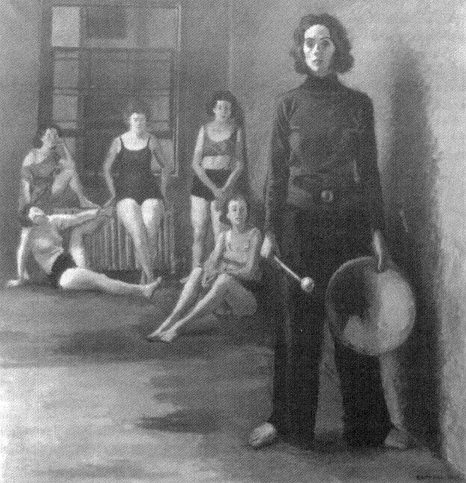
6.24
Raphael Soyer, Fé Alf and Her Pupils , 1935. Oil on canvas, 40" × 37 7/8". Collection of
The Newark Museum.
In 1936 Soyer also painted one of only two "activist" images he claims ever to have attempted; in it he took up the theme of militancy related to the Spanish civil war, the event that galvanized the Popular Front. In Workers Armed (Fig. 6.25—see also The Crowd , Fig. 3.35) Soyer drew inspiration directly from Daumier's 1863 painting The Uprising (Fig. 6.26). In Soyer's work armed men and women packed closely together call out and march toward an unseen enemy. The crowd is brilliantly illuminated, and one young man looks out toward the viewer, soliciting
support. In this work Soyer aligned himself specifically with other liberals and radicals who faulted American neutrality as well as the government's embargoing the sale of munitions to either side in the war. Because Hitler and Mussolini regularly supplied the fascist insurgents with arms, the Loyalists were left at an extreme disadvantage. Soyer legitimated the aesthetic component of his political art by invoking Daumier, an established "old master" of political themes and of the direct manner of painting that had come to be associated with a social or a people's art. In this way he took up a common aesthetic strategy of Popular Front artists. Broadening their aesthetic base to include both representational and modernist styles of oil painting, they diffused the charges of propaganda leveled at political graphics calling for direct action that had been produced and approved by the American Left in the more sectarian period of the early thirties. Soyer found in the liberalized political, cultural, and aesthetic strategies employed in the Popular Front era the means to respond to the threat of fascism and to express his solidarity with the cause of Spanish Loyalists in their civil war.[78]
The tension and interrogation in Shop Girls was thus part of a broader agenda that included the American artist's rising concern with international politics and its effects on the community at large in the 1930s. Similar concerns filtered into debates about the role of working women. In her study of the Depression's effects on these women, for example, the sociologist Lorine Pruette argued that they must protect their rights against the "fascist" tendency to return them to the home. She stated further that no family or society could develop when women were denied the "right to function according to their abilities, needs and desires."[79] Even as Soyer's Shop Girls directs the viewer to speculate on the conditions under which women labored, the individual figures continue to assert their need for that work. Window Shoppers (Fig. 6.2 and Plate 5), a work that portrays several of women's possible roles, can be read according to this late-thirties political agenda as a reassertion of women's rights in a democratic society.
Even though Soyer's art was more confrontational in these mid-decade years than it had been, it never became revolutionary or propagandistic—that was not what Soyer wanted. Nor apparently is that what the broadened critical agenda of the leftist press required of revolutionary artists, especially during the Popular Front era and the years immediately following. How to create a revolutionary art was debated in Art Front , the periodical published by the Artists' Union from October 1934 to December 1937. Soyer would have been well acquainted with the periodical because his brother Moses wrote for it; and debates in print carried over to the regular Wednesday night meetings of the Artists' Union that Soyer attended.[80]
By the fall of 1935, among leftist intellectuals and within the Communist party, there was a general reorientation away from a militant revolutionary posture toward the more peaceful collective aims of the Popular Front movement; Communists joined Socialists, Democrats, and members of the middle class to preserve
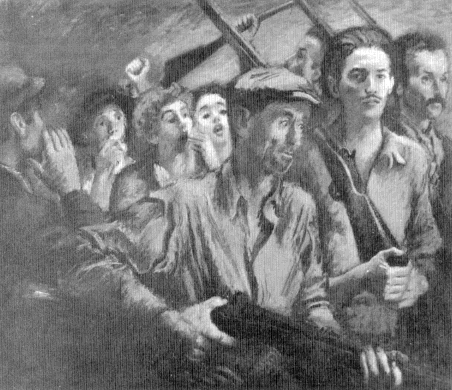
6.25
Raphael Soyer, Workers Armed , c. 1936-37. Oil on canvas. Private collection.
the values of democracy and social progress against the threat of fascism. At the same time, there was an attempt to broaden and liberalize the aesthetic debate about revolutionary art. Reviewers in Art Front explored ways by which an artist could make a revolutionary art without sacrificing the quality of the work or producing mere propaganda.[81] Harold Rosenberg, for example, wrote that no single work by an artist needed to make a full revolutionary statement:
The principle—art is propaganda—recognizes the fact that the picture-world of the painter includes within it elements of many kinds, some confined to the world of simple appearance, some introducing into appearance action-motives and a critique of values; and that this picture-world, as an entirety, deflects the mentality of society in one direction or another.[82]
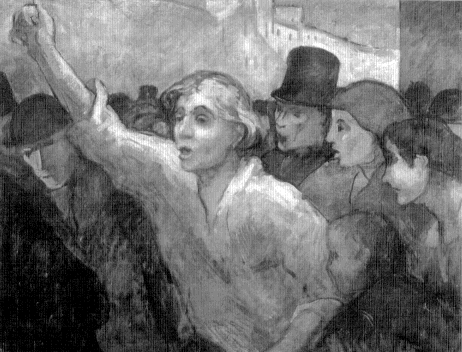
6.26
Honoré Daumier, The Uprising , undated. Oil on canvas, 34 1/2" × 44 1/2". The Phillips
Collection, Washington, D.C.
Whereas Rosenberg discussed pictorial possibilities and implied that an artist's total style could embody many social ideas, the artist Louis Lozowick claimed that a revolutionary art opened up a new range of possibilities for subject matter within the artist's environment. In a July-August 1936 issue of Art Front , Lozowick's long list of subject possibilities included relations between and within classes and the "worker as victim" as important new avenues of investigation.[83]
Soyer's working women were new subjects. The shopgirl, as she came to be understood, was virtually unknown in the iconography of American art. By selecting her as his subject, Soyer was bringing to consciousness an image of the female working-class wage earner, who had been supplanted by the saleswoman, a middle-class model of success. Her victimization is expressed not only by painted effects of weariness but also, more subtly, by her suspended but moving state. She is between environments, linked to (but not interacting with) her fellow workers,
alienated, in short, from her workplace, from her class, and from traditional mainstream beliefs about the role of her gender. Though never part of his expressed artistic intentions, Soyer's carefully coded pictorial strategies can be read at the conjunction of competing discourses on art, society, politics, and gender. He experienced these in moving from his own social milieu as an immigrant artist to the established world of American art in the late 1920s and 1930s and from there to the meeting places of the decade's most spirited debates on art and politics. The reading of the image I propose here is possible only when we begin to unravel the work's meaning within and between these sites of production and reception.
Although we lack complete evidence by which to evaluate Soyer's own response to feminist arguments for—or public sentiments against—women's work during the Depression, we can conjecture that the artist's values and personal experiences would have made him sympathetic to women's right to work. By showing women in transition and by asserting their womanliness, Soyer's painting affirms their acceptability as youthful, temporary members of the work force. By making them objects available for contemplation, through traditional studio picture formats, the artist made them into a work of art, thereby confining them to a constricted social space defined by looking. Even as the paintings reinforce the mainstream ideology that women had their proper place, the women are brought close to the viewer and return the viewer's gaze. This tactic, when combined with an individualized working-class subject, reinscribes class into the image as part of the viewer's social world; class is no longer a force made distant through a deeper space, a stereotyped figure, or a middle-class setting of consumption. By such means, the painting engages the working ambiance around Union Square more fully than other works by the Fourteenth Street School. It stages a muted interrogation of the social order for the viewer. And finally, Soyer's Shop Girls holds in visual suspension the ambiguous and problematic relationship between femininity and labor in the Depression.